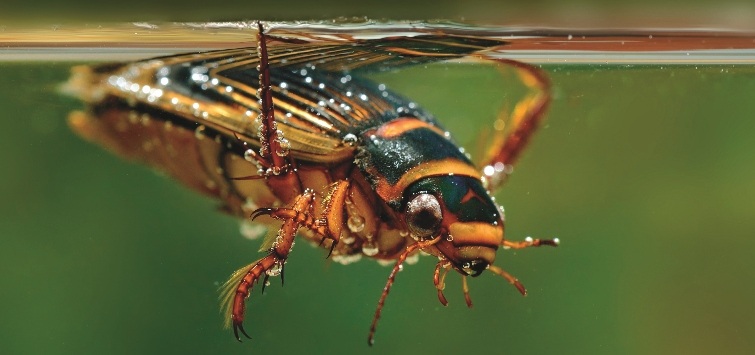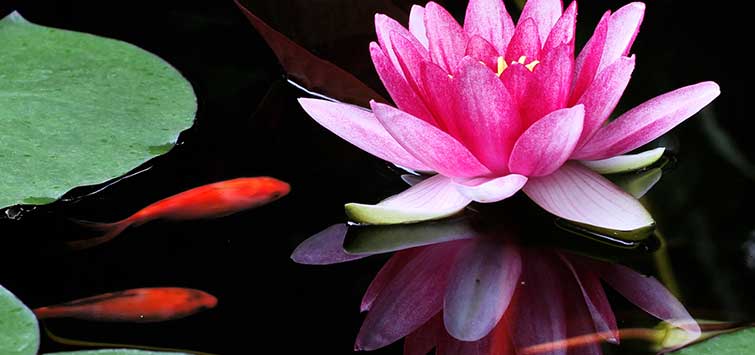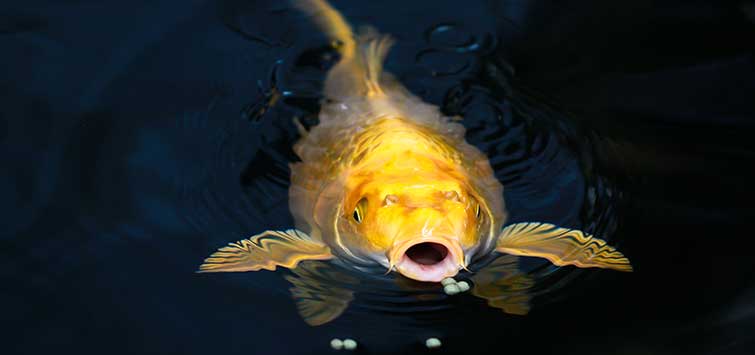Tiny Terrors: Pond Insects and Other Invert Invaders
When it comes to invertebrates and fish, we tend to have a one-way view of the predator-prey aspect of their relationships: when the two meet, it is usually the invert that gets gobbled down by the fish. We feed our aquarium fish brine shrimp, worms, daphnia, and all sorts of invertebrates, and in the wild fallen insects (and some that venture too close to the water surface) are taken with gusto.
But that clear concept of what is predator and what is prey can be flipped on its head, with many invertebrates enjoying the occasional sashimi dinner. As many pondkeepers will attest, pond insects and other inverts can be spineless, cold-blooded little fish killers.
Dragonflies
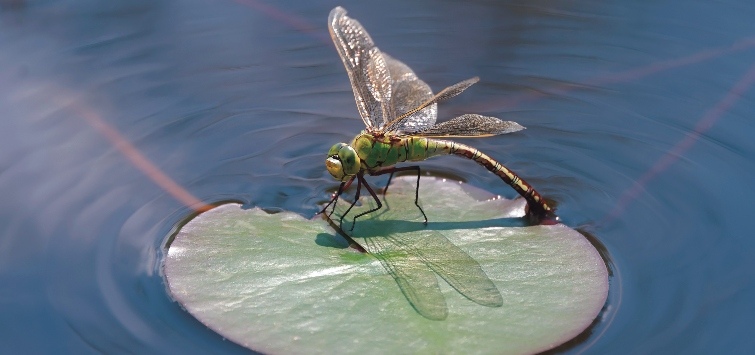
A female dragonfly will lay eggs on the underside of water plants. When the larvae, also known as naiads or nymphs, hatch, they are completely aquatic. (There are some rare exceptions, especially from the Pacific islands, where the nymph stages of some species are terrestrial.) The larvae breathe through external gills found at the tip of their abdomens and are generally visible as small prongs. The gills serve double-duty, allowing the larvae to move through the water, much like a fish moving its tail laterally back and forth. While the adult stage of these pond insects may live only a few months, many nymphs live as aquatic predators for years.
The nymphs are voracious predators, much like their parents. The only difference is that, unlike the adults, which feed often on insects on the wing, the larvae are restricted to feeding on aquatic life, most often mosquito larvae, but also on small fish and tadpoles smaller than, and up to equal in length to, themselves.
A dragonfly larva will stay submerged on the substrate awaiting prey to come near. When prey comes to within striking distance, it will explosively extend itself to seize its victim. Though ravenous, their jaws are not particularly strong, having evolved to take much smaller insect larvae prey. As a result, a small fish caught in its grasp may escape. Even though this may be the case at times, do not underestimate the voracity of this predator.
Dragonflies are related to a similar insect group known as damselflies (suborder Zygoptera). Adults are easy to tell apart; dragonflies are larger than damselflies, and their wings are not folded when not moving. Damselflies fold their wings above them, like a butterfly. Damselfly larvae are generally smaller and slimmer than dragonfly larvae and always have three long tails, which are often leaf- or feather-like, though they may be spiny. Although their lifecycle is similar to that of dragonflies, damselfly larvae are relatively small and do not pose a risk to fish.
Water Tigers & Diving Beetles
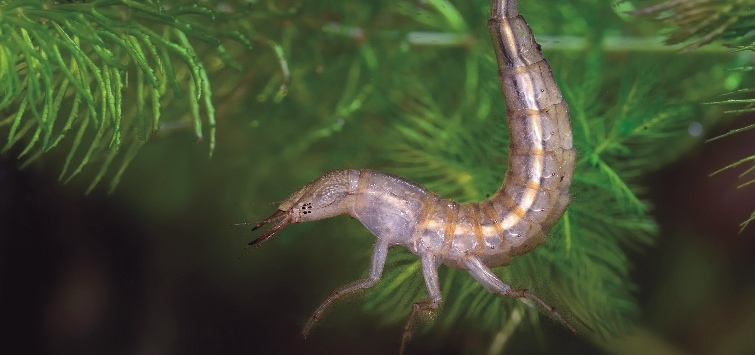
The water tiger appears much like a flattened caterpillar, up to 2 inches (5 cm) in length. That is where the similarity ends. When you reach the mouth parts, you will find that the water tiger is equipped with a set of hollow, sickle-like pincers that allow the larvae to inject digestive enzymes into its prey, thus starting the feeding process and letting them suck a predigested soup from the unfortunate victim.
The ravenous appetite of the water tiger does not end when it grows up, either. It matures into the equally deadly, though somewhat smaller—around 1 inch (2.5 cm)—predaceous diving beetle. With two pairs of long, flattened hind limbs with hair-like extensions to increase their surface area, the beetles are easily able to float on the water surface, tail-end up, while looking down into the water for potential prey.
Predaceous diving beetles are excellent swimmers. They are also excellent fliers and will often move from one body of freshwater to another. Representing approximately 4,000 different species, these beetles can be found in almost any body of freshwater all around the world.
Despite their lack of gills, they are able to stay underwater for a very long time. They do so by carrying a bubble of air below the water surface and holding it under their wings. Like their larval form, diving beetles feed through a hollow set of pincers. Once they grasp their prey, whether it’s an insect, fish, or tadpole, they inject digestive enzymes to liquefy their victim from the inside out.
A similar but harmless insect known as the scavenger beetle may confuse some pond owners into thinking that they have predaceous diving beetles. To differentiate between diving beetles and scavenger beetles, look closely and you will see a telltale difference. The diving beetles swim by moving their elongated hind legs concurrently, whereas scavenger beetles swim by alternating the movement of their hind limbs.
While the larvae of scavenger beetles are predatory, they essentially concentrate on the capture of aquatic invertebrates such as insect larvae and snails. The adults feed, their common name suggests, on dead and decaying plants and animals.
Backswimmers
Hardly possessing the ferocity of their other insect brethren, backswimmers (of the family Notonectidae) are a group of insects made up of around 200 species. Despite their lesser reputation, they are aggressive and can often be found in backyard swimming pools, where they can deliver a painful bite to human swimmers.They are known as backswimmers for the very reason that they swim upside-down and backwards, and they range in size from about ¼ to ¾ inches (.5 to 2 cm) in length, depending on which of the 350 species they are. They are all predatory, swimming quickly through the water by moving their extra-long, hair-fringed hind legs to attack and capture prey—often other insects, but also small fish and tadpoles.
They feed by stabbing their victims with a tubular mouthpart and injecting them with digestive enzymes. One ray of hope if you find this potential killer in your pond is the fact that they often shy away from water bodies that contain fish and fly on to a body of water that is of a lesser threat.
Backswimmers are often confused with their cousins, the water boatmen of the family Corixidae. However, though some species will eat invertebrate larvae, water boatmen are otherwise herbivorous. They are distinguished from backswimmers in that they swim upright and forward by moving two pairs of large, oar-like appendages.
Hydra
There is a distant relative of the jellyfish that inhabits a number of freshwater habitats across the temperate and tropical world: the genus Hydra, made up of about 25 species. Biologists are especially interested in the animals, because, like the jellyfish, they are essentially immortal, never appearing to age or die. Instead, these hermaphroditic organisms are able to continue to reinvent themselves by budding.They grow up to a little over an inch (2.5 cm) in length, with a remarkable ability of contraction that allows them to appear much smaller. They are normally sessile, adhering to the substrate via a basal disk that secretes a glue-like substance that secures it in place.
At the other end of the organism, there is a mouth-like opening that is surrounded by branches made up of one to up to 25 tentacles known as cnidae. At the end of the tentacles are structures known as nematocysts. When one of the nematocysts contacts prey, be it insect larvae, daphnia (its preferred prey), or small fish, the nematocysts discharge thread-like darts into the prey animal, inoculating it with immobilizing toxin.
They are normally not a hazard to larger fish—in fact, larger fish will eat them—but fish fry and smaller adult fish are always potential prey.
Fighting Off the Killers
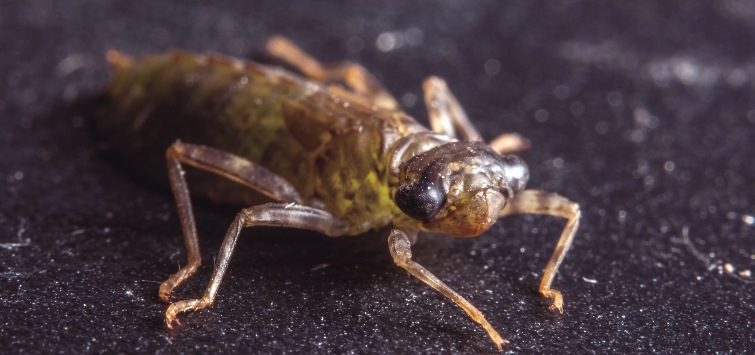
Once established, many of these enemy organisms are almost impossible to eradicate, so prevention is the key. If a random killer invert were to make its way into your indoor aquarium, it would be large enough to see and simple enough to remove physically. In an outdoor pond, however, these killers are more of a potential problem—they can make their way into your pond quite easily, and they are harder to detect and more difficult to eradicate in a relatively large body of water that is viewed from above.
Since some of these invertebrates adhere to the substrate or sides of the pond, frequent cleaning, including vacuuming of the sides and bottoms, will go a long way toward preventing their establishment. Others, such as the predaceous diving beetle hovering at the surface or backswimmers streaming through the water column, once identified, can be removed with a skimmer.
Since many of the water enemies are also flying insects that move from pond to pond quite easily, a cover of sorts will prevent not only insect predators from entering the pond but also from laying their eggs. You can do this by purchasing a pond cover that allows free airflow between the water and the air, thus ensuring that oxygen levels are maintained.
You can also make your own cover. By using PVC pipe as framing material and window screen as the mesh, you can create an effective barrier to flying insects that come to wreak havoc on your pond. In addition, plant-essential sunlight can filter through the screen.
What about the Hydra, though? How do you kill an “immortal”? Unlike flying pond insect larvae, Hydra are introduced in some way by aquarists and pondkeepers themselves. If you are providing your pond fish with a delicious meal of daphnia, be sure you know and trust the source. Be wary of getting them from natural ponds and other waterways in your community, since daphnia and Hydra often come as a package deal. Purchase your daphnia instead from a reputable dealer.
Hydra can also be introduced by contamination of ornaments or plants placed into the water. Carefully cleaning them before putting them in your pond or aquarium will prevent another potential source of this destructive invader.
If the organism does somehow gain a foothold in your pond or aquarium, you can always treat the water with chemicals available at most pet supply stores. Chemicals containing copper sulphate or potassium permanganate will eliminate a Hydra problem, but remember that one of these solutions could be just as hard on your plants and animals. Follow all directions of the manufacturer carefully. Some pond owners and aquarists claim that using anti-helminthic remedies as prescribed is also effective in eliminating any Hydra issues.

.png?h=595&iar=0&w=2781&hash=5FD5E69473BCC22199FBFA2FB71B6033)
